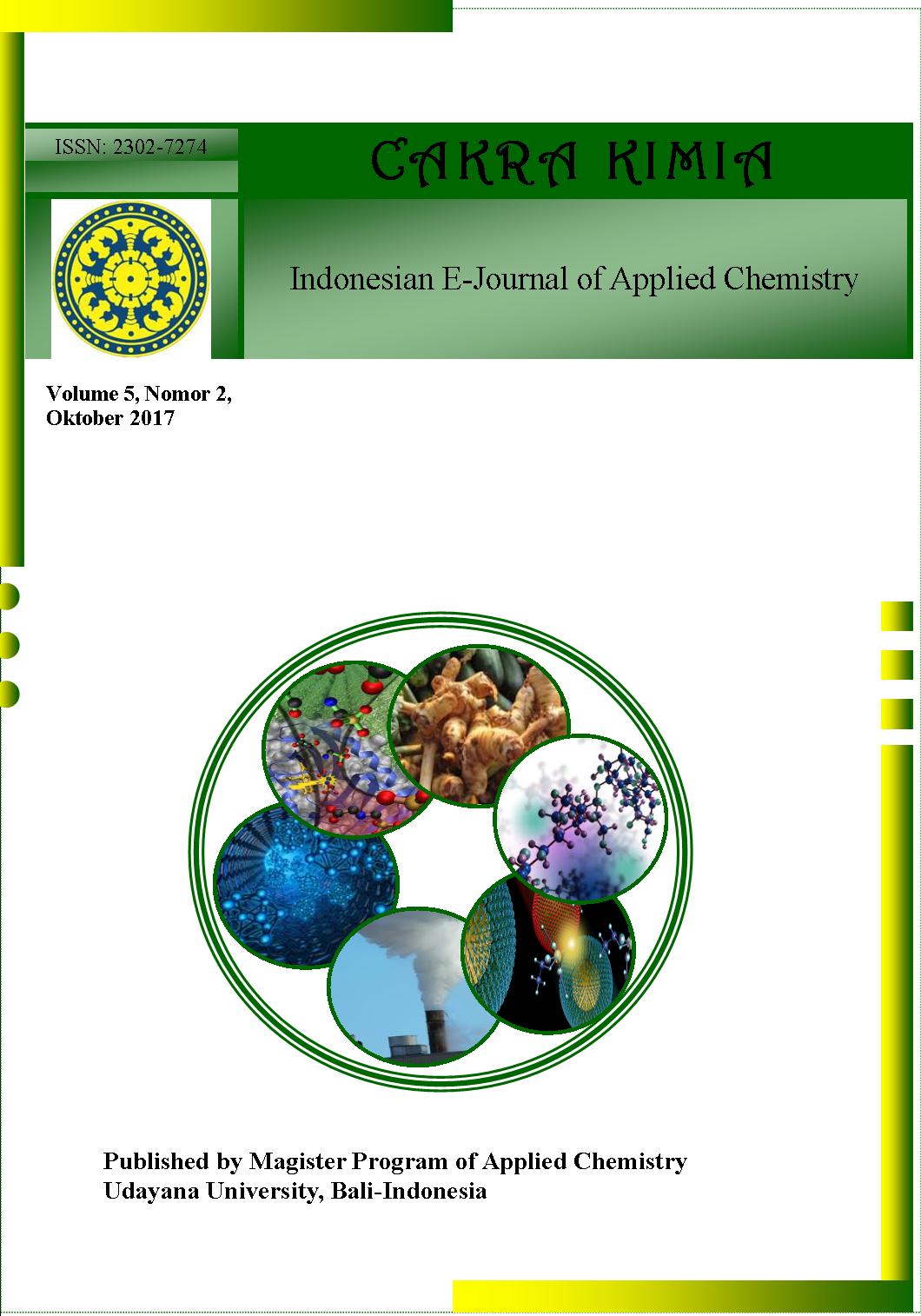SPESIASI DAN BIOAVAILABILITS LOGAM BERAT Pb DAN Cu PADA SEDIMEN LAUT DI KAWASAN PANTAI CELUKAN BAWANG KABUPATEN BULELENG-BALI
Abstract
ABSTRAK: Karakteristik logam berat pada organisme dan sistem ekologis tidak dapat diterangkan hanya dengan mengetahui kandungan logam total dalam perairan, melainkan dengan penentuan bentuk geokimia atau spesies logam tersebut. Penelitian ini bertujuan untuk menentukan spesiasi dan bioavailabilitas logam berat Pb dan Cu pada sedimen di Kawasan Pantai Celukan Bawang Buleleng, Bali. Analisis logam total, spesiasi dan bioavailabilitas ditentukan dengan menerapkan metode digesti dan ekstraksi bertahap. Kandungan logam Pb dan Cu total dalam sedimen Pantai Celukan Bawang berturut-turut 17,2865-39,4533 mg/kg dan 12,9665-56,1346 mg/kg. Spesies logam Pb paling banyak berada sebagai fraksi resistant (29,75-67,10%), diikuti oleh fraksi tereduksi asam (22,45-31,67%), fraksi EFLE (easily, freely, leachable, exchangeable) dengan kisaran dari tidak terdeteksi (ND) hingga 29,33%, dan yang terendah berasosiasi dengan fraksi teroksidasi organik (ND-14,18%). Spesies logam Cu juga didominasi oleh fraksi resistant (80,52-90,22%), fraksi teroksidasi organik (4,81-17,20%) berada pada urutan ke dua, diikuti oleh fraksi EFLE (0,88-5,83%), dan terrendah adalah fraksi tereduksi asam (ND-1,14%). Bioavailabilitas logam Pb yang sertamerta bioavailabel berkisar ND-29,33% dan yang berpotensi bioavailabel adalah 33,35-42,78%, sedangkan logam Pb yang nonbioavailabel adalah 29,75-67,10%. Berbeda dengan Pb, logam Cu didominasi oleh bentuk non bioavailabel yaitu berkisar 80,52-90,22%, diikuti oleh Cu yang berpotensi bioavailabel, yaitu 5,95-16,61%, dan terkecil adalah Cu yang bersifat sertamerta bioavailabel (0,88-5,83%).
ABSTRACT: The characteristics of heavy metals in organisms as well as on ecological systems cannot be explained by the only knowing total metal contents in sediments but also by determining the geochemical forms or the metal species in the sediments. This study aimed to determine the speciation and bioavailability of heavy metals, Pb and Cu in sediments of Celukan Bawang Beach area of Singaraja, Bali. The total metals, speciation and bioavailability analysis were determined by applying a digestion and sequential extraction methods. The total metal contents of Pb and Cu in the sediments were 17.2865-39.4533 mg/kg and 12.9665-56.1346 mg/kg, respectively. The species distribution of the metals in the sediments was as follows: species of Pb was dominated by the form of resistant fraction (29.75-61.10%), followed by reducible acid fraction (22.45-36.25%), EFLE fraction (easily, freely, leachable, exchangeable) ranging from undetectable (ND) to 29.33%, and the lowest percentage fraction was associated with the organic oxidizable phase (ND-14.18%). The resistant fraction was also the most dominant for Cu (80.52-90.22%), but the oxidizable fraction (4.81-17.20%) was found in the second level, followed by the EFLE fraction (0.88-5.83%), and the lowest was associated with reducible fraction (ND-1.14%). The readily bioavailable Pb ranged from 3.62 to 29.33% and potentially bioavailable Pb was 33.35-42.78%, nonbioavailable Pb was 29.75-61.10%. Different from Pb, Cu metal was dominant as non bioavailable metal (80.52-90.22%), but 0.88-5.83% of the Cu was readily bioavailable and 5.95-16.61% was potentially bioavailable.
Downloads
References
[2] Davidson, C.M., R.P. Thomas, S.E. McVey, R. Perala, D. Littlejohn, and A.M. Ure. 1994. Evaluation Of A Sequential Extraction Procedure For The Speciation Of Heavy Metals In Sediments. Analytica Chemica Acta, 291: 277-286
[3] Batley, G.E. 1987. Heavy Metal Speciation in Waters, Sediments, and Biota from Lake Macquirie. New South Wales
[4] Siaka, M., Owens, C. M., and Birch, G. F. 1998. Evaluation of Some Digestion Methods For The Determination of Heavy Metals In Sediment Samples By Flame-AAS. Analytical Letters. 31(4): 703-718.
[5] Darmono, 1995, Logam Dalam Sistem Biologi Makhluk Hidup, UI-press, Jakarta
[6] Siaka, I M., I G. A. M. D. A. Suastuti, I P. B. Mahendra. 2016. Distribusi Logam Berat Pb dan Cu Pada Air Laut, Sedimen, dan Rumput Laut di Perairan Pantai Pandawa. Jurnal Kimia. 10(2): 190-196
[7] Reichman, S.M.A. 2002. The Response Of Plant To Metal Toxicity: A Review Of Focusing On Copper, Magnase And Zinc, Australian Minerals And Energy Environment Foundation: Melbourne, Australia.
[8] Badri, M. A. and S. R, Aston. 1983. Observations In Heavy Metal Geochemical Associations In Polluted And Non-Polluted Estuarine Sediments. environmental pollution (series B). 6, pp. 181-193.
[9] Gasparatos, D., C. Haidouti, adrinopoulos and O, areta., 2005. Chemical Speciation And Bioavailabiliyy Of Cu, Zn And Pb In Soil From The National Garden Of Athens, Greece, Proceedings: International Conference On Environmental Science And Technology, Rhodes Island, Greece, 1 – 3 September 2005.



 Petunjuk Penulisan
Petunjuk Penulisan
